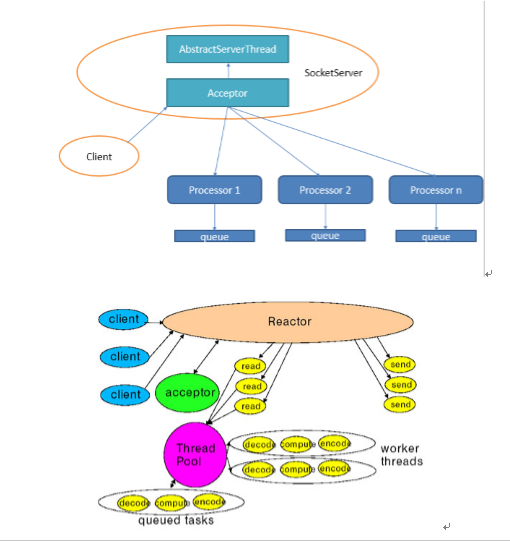总结一点常见的NIO程序的写法,虽然没有一个固定的格式,也没有特别大的差别,但是多总结总结各位大师的写法,多见点儿组合还是对自身代码的质量有很大提高的。这一篇我想通过对kafka network包下的源码进行分析,然后抽取第一种比较常见的写法。之前已经写过一篇关于kafka通信源码的解读,可参见http://my.oschina.net/ielts0909/blog/102336,最近再改写一些源码,所以还是有必要把更完整的认识更新上来。
当然这不是最常见的写法,最常见,也是大多数人都能接受的代码可以参考http://my.oschina.net/ielts0909/blog/89849文中的代码,当然在read或者write的时,更多的会采用多线程来处理。
各种写法的本质都是一样的,可能我们要更注重比较不同细节的写法,kafkaSocketServer的代码主要在kafka broker端使用,是最基础的服务端通信类。在kafka代码中,与常见写法区别比较大的就是将选择器键的接收部分(acceptor)单独拿出来写了。再通过接收器(acceptor)将读写的任务交付给更多个处理器(processor)。在处理器中采用队列的形式按先进先出的顺序对读写进行操作。

我特意将图画的跟reactor模式的图差不多的形式,其实两者的本质也没什么差别,主要看怎么去实现acceptor与多线程处理读写操作。

我用java改写了部分kafka的代码,这样便于阅读,我们看AbstractServerThread中的一些细节,这个类主要定义了startup、shutdown相关的一系列方法,这些方法通过闭锁来同步多线程执行的顺序。这个类直接向子类提供了selector对象。
package org.gfg.inforq.network;
import java.io.IOException;
import java.nio.channels.Selector;
import java.util.concurrent.CountDownLatch;
import java.util.concurrent.atomic.AtomicBoolean;
import org.slf4j.Logger;
import org.slf4j.LoggerFactory;
/**
* A base class for server thread with several variables and methods
*
* @author Chen.Hui
* @since 0.1
*/
public abstract class AbstractServerThread implements Runnable {
protected Selector selector;
private static final Logger LOG = LoggerFactory
.getLogger(AbstractServerThread.class);
private CountDownLatch startupLatch = new CountDownLatch(1);
private CountDownLatch shutdownLatch = new CountDownLatch(1);
private AtomicBoolean alive = new AtomicBoolean(false);
protected AbstractServerThread() throws IOException {
this.selector = Selector.open();
LOG.info("selector is opening");
}
/**
* shutdown the running therad
* @throws InterruptedException
*
*/
protected void shutdown() throws InterruptedException {
alive.set(false);
selector.wakeup();
shutdownLatch.await();
}
/**
* Causes the current thread to wait until the latch has counted down to
* zero, unless the thread is interrupted.
* @throws InterruptedException
*/
protected void awaitStartup() throws InterruptedException {
startupLatch.await();
}
/**
* releasing all waiting threads if the count reaches zero.
*/
protected void startupComplete() {
alive.set(true);
startupLatch.countDown();
}
/**
*
*/
protected void shutdownComplete() {
shutdownLatch.countDown();
}
/**
*
* @return true only this thread is startup complete
*/
protected boolean isRunning(){
return alive.get();
}
}Acceptor的作用也仅仅就是accept。我们可以注意到Acceptor引用了一系列的Processor,然后为每个processor与一个key绑定。并将相应的通道传递给processor。所以总结起来acceptor做了两件事,绑定key和processor,并将通道传递给相应的processor。
package org.gfg.inforq.network;
import java.io.IOException;
import java.net.InetSocketAddress;
import java.nio.channels.SelectionKey;
import java.nio.channels.ServerSocketChannel;
import java.nio.channels.SocketChannel;
import java.util.Iterator;
import java.util.Set;
import org.slf4j.Logger;
import org.slf4j.LoggerFactory;
/**
*
* @author Chen.Hui
*
*/
public class Acceptor extends AbstractServerThread {
protected int port;
private Processor[] processors;
protected int sendBufferSize;
protected int receiveBufferSize;
private static final Logger LOG=LoggerFactory.getLogger(Acceptor.class);
public Acceptor(int port, Processor[] processors, int sendBufferSize,
int receiveBufferSize) throws IOException {
//super();
this.port=port;
this.processors=processors;
this.sendBufferSize=sendBufferSize;
this.receiveBufferSize=receiveBufferSize;
}
public void run() {
try {
ServerSocketChannel serverChannel = ServerSocketChannel.open();
serverChannel.configureBlocking(false);
serverChannel.socket().bind(new InetSocketAddress(port));
serverChannel.register(selector, SelectionKey.OP_ACCEPT);
LOG.info("Awaiting connections on port "+port);
startupComplete();
int currentProcessor=0;
while(isRunning()){
int ready=selector.select(500);
if(ready>0){
Set<SelectionKey> keys=selector.selectedKeys();
Iterator<SelectionKey> iter=keys.iterator();
while(iter.hasNext()&&isRunning()){
SelectionKey key=null;
try{
key=iter.next();
iter.remove();
if(key.isAcceptable()){
accept(key,processors[currentProcessor]);
}else{
throw new IllegalStateException("Unrecognized key state for acceptor thread");
}
currentProcessor=(currentProcessor+1)%processors.length;
}catch (Exception e) {
LOG.error(" ",e);
}
}
}
}
serverChannel.close();
selector.close();
shutdownComplete();
} catch (IOException e) {
e.printStackTrace();
}
}
private void accept(SelectionKey key, Processor processor) throws IOException {
ServerSocketChannel ssc=(ServerSocketChannel) key.channel();
ssc.socket().setReceiveBufferSize(receiveBufferSize);
SocketChannel socketChannel=ssc.accept();
socketChannel.configureBlocking(false);
socketChannel.socket().setTcpNoDelay(true);
socketChannel.socket().setSendBufferSize(sendBufferSize);
if(LOG.isDebugEnabled()){
LOG.debug("sendBufferSize:["+socketChannel.socket().getSendBufferSize()+"] receiveBufferSize:["+socketChannel.socket().getReceiveBufferSize()+"]" );
}
processor.accept(socketChannel);
}
}Acceptor里也没做什么策略直接将任务按照currentProcessor=(currentProcessor+1)%processors.length;的形式分配,如果做的更好的话,可以按照任务的权重、执行时间等重新分配。另外要注意这里调用的一些AbstractServerThread里的方法。
Processor类中主要做的就是读写操作,这部分没有什么特别突出的不同,在类里引用了队列来存储由acceptor分发过来的通道,并按顺序处理。
package org.gfg.inforq.network;
import java.io.IOException;
import java.nio.channels.ClosedChannelException;
import java.nio.channels.SelectionKey;
import java.nio.channels.SocketChannel;
import java.util.Iterator;
import java.util.Set;
import java.util.concurrent.ConcurrentLinkedQueue;
import org.slf4j.Logger;
import org.slf4j.LoggerFactory;
public class Processor extends AbstractServerThread {
private final int maxRequestSize;
public Processor(int maxRequestSize) throws IOException {
super();
this.maxRequestSize=maxRequestSize;
}
private ConcurrentLinkedQueue<SocketChannel> newConnections = new ConcurrentLinkedQueue<SocketChannel>();
private static final Logger LOG = LoggerFactory.getLogger(Processor.class);
public void run() {
/** make sure the selector is open completely */
startupComplete();
while (isRunning()) {
try {
// setup any new connections that have been queued up
configureNewConnections();
int ready = selector.select();
if (ready > 0) {
Set<SelectionKey> keys = selector.selectedKeys();
Iterator<SelectionKey> iter = keys.iterator();
while (iter.hasNext() && isRunning()) {
SelectionKey key = null;
try {
key = iter.next();
iter.remove();
if (key.isReadable()) {
//
read(key);
} else if (key.isWritable()) {
//
write(key);
} else if (key.isValid()) {
//close
close(key);
} else {
throw new IllegalStateException("Unrecognized key state for processor thread");
}
} catch (Exception e) {
if (e instanceof IOException) {
}
}
}
}
} catch (Exception e) {
// TODO: handle exception
}
}
}
private void read(SelectionKey key) {
SocketChannel socketChannel=channelFor(key);
Receive request=(Receive) key.attachment();
if(key.attachment()==null){
request=new BoundedByteBufferReceive(maxRequestSize);
key.attach(request);
}
int read=request.readFrom(socketChannel);
if(LOG.isTraceEnabled()){
LOG.trace(read+" bytes read from "+socketChannel.socket().getRemoteSocketAddress());
}
if(read<0){
close(key);
return;
}else if(request.complete){
handle(key,request);
}
}
private void handle(SelectionKey key, Receive request) {
// TODO Auto-generated method stub
}
private void write(SelectionKey key) {
Send response= (Send) key.attachment();
SocketChannel socketChannel=channelFor(key);
int written =response.writeTo(socketChannel);
if(LOG.isTraceEnabled()){
LOG.trace(written+" bytes written to "+socketChannel.socket().getRemoteSocketAddress());
}
if(response.complete){
key.attach(null);
key.interestOps(SelectionKey.OP_READ);
}else{
key.interestOps(SelectionKey.OP_WRITE);
selector.wakeup();
}
}
private SocketChannel channelFor(SelectionKey key){
return (SocketChannel) key.channel();
}
/**
* close the channel
* @param key
*/
private void close(SelectionKey key) {
SocketChannel channel=(SocketChannel) key.channel();
if(LOG.isDebugEnabled()){
LOG.debug("Closing the connection from"+channel.socket().getRemoteSocketAddress());
}
if(channel.isOpen()&&channel.socket().isConnected()){
try {
//care the sequence of closing
channel.socket().close();
channel.close();
key.attach(null);
key.cancel();
} catch (IOException e) {
LOG.info(e.getMessage(),e);
}
}
}
private void configureNewConnections() {
while (newConnections.size() > 0) {
SocketChannel channel = newConnections.poll();
if (LOG.isDebugEnabled()) {
LOG.debug("linstening to a new connection from "
+ channel.socket().getRemoteSocketAddress());
}
try {
channel.register(selector, SelectionKey.OP_READ);
} catch (ClosedChannelException e) {
LOG.info("the channel has been closed..");
continue;
}
}
}
public void accept(SocketChannel socketChannel) {
newConnections.add(socketChannel);
selector.wakeup();
}
}我也无法说出这种将接收器单独拿出来写的方式到底好处在哪里,但是这样的写法结构清晰,各个组件分工明确,还是很值得学习的。总结的目的不就是为了学习各种优秀的东西么。






















 249
249

 被折叠的 条评论
为什么被折叠?
被折叠的 条评论
为什么被折叠?








